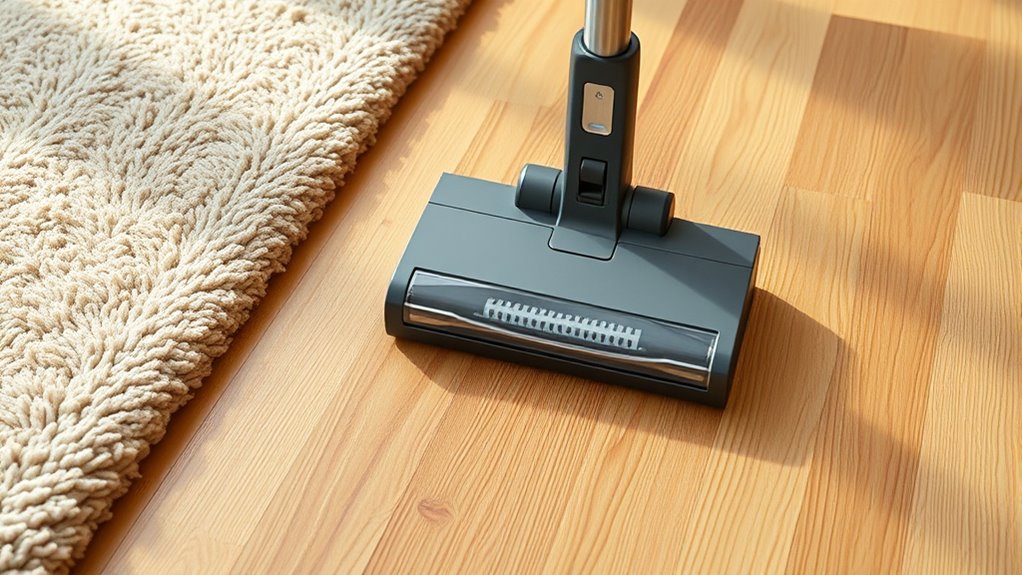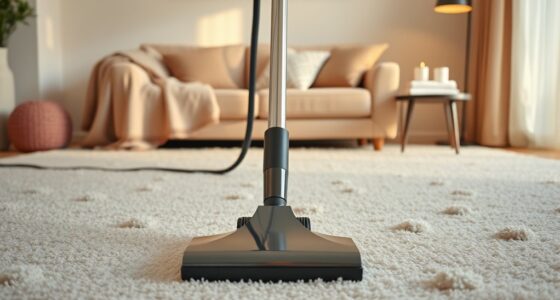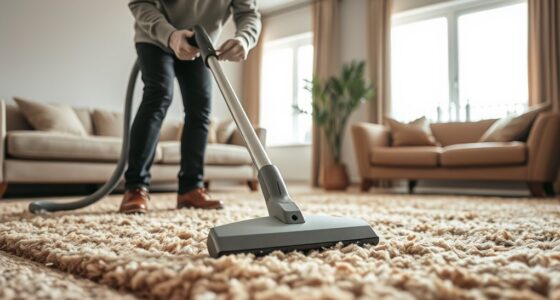To clean mixed flooring in one pass, start by adjusting your vacuum’s height for each surface, lowering it for carpets and raising it for hardwood or tile. Use adjustable suction power—more for carpets, less for delicate surfaces—to protect finishes. Switch to specialized attachments if needed, especially on sensitive floors. Slowly cross shift points while maintaining consistent settings to avoid damage. For tips on refining these adjustments, keep exploring to optimize your vacuum’s performance.
Key Takeaways
- Use an adjustable vacuum with height settings to easily switch between surface types during a single pass.
- Adjust suction power based on surface sensitivity and debris type, increasing on carpets and lowering on hardwood or tiles.
- Employ specialized attachments for different surfaces, such as soft brushes for hardwood and motorized brushes for carpets.
- Slow down at transition points like thresholds to maintain control and prevent damage.
- Regularly fine-tune and test settings on small areas to optimize cleaning efficiency across mixed flooring.
Assessing Your Flooring Types and Their Needs
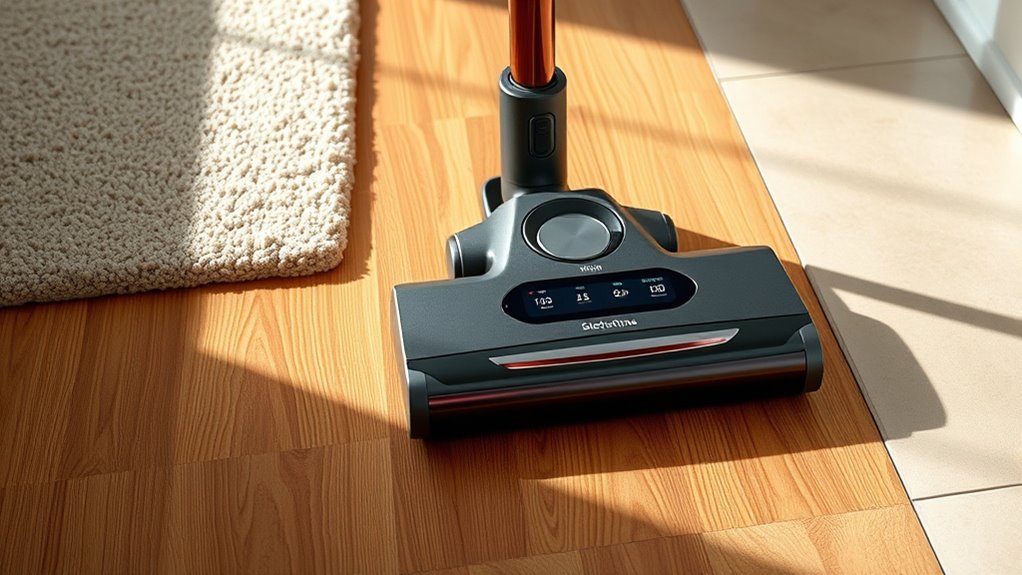
Understanding your flooring types is essential to choosing the right vacuum settings. Different surfaces, like hardwood, carpet, or tile, require specific care to prevent damage and ensure thorough cleaning. For instance, delicate hardwood floors benefit from gentle vacuum settings, while carpets need more suction power. Evaluating your flooring helps you determine the appropriate vacuum maintenance routines and storage solutions, ensuring your vacuum operates efficiently without unnecessary wear. Proper storage solutions also keep attachments and brushes in good condition, making it easier to switch settings as needed. Taking the time to evaluate your floors means you’ll get better cleaning results, extend your vacuum’s lifespan, and avoid costly repairs. Regularly reviewing your paint sprayer accessories and adjusting your cleaning approach can also help maintain optimal performance. This proactive approach keeps your home cleaner and your vacuum functioning at its best.
Adjusting the Vacuum Height for Different Surfaces
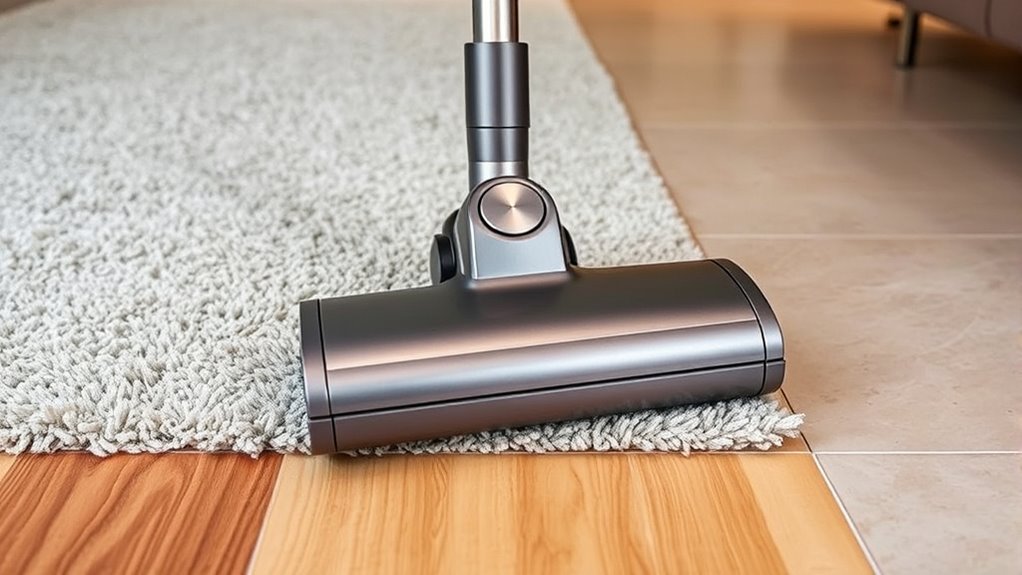
To clean effectively, you need to adjust your vacuum height based on the surface you’re working on. For carpets, you might want it lower to pick up deeply embedded dirt, while hard floors require a higher setting to prevent damage. Always check that your suction stays strong and consistent as you switch between surfaces. Additionally, ensuring your vacuum has the appropriate adjustable settings can optimize performance across different flooring types.
Surface Type Considerations
The key to effective vacuuming is adjusting the height based on the surface you’re cleaning. For different surfaces, your vacuum’s height should be tailored to avoid damage and maximize suction. When working on hardwood or tile, set the vacuum slightly higher to prevent scratching and protect the vacuum filter from debris buildup. For surfaces like vinyl or laminate, a medium setting ensures thorough cleaning without causing wear. Keep an eye on your cord length to maintain consistent power and avoid unnecessary stops—longer cords give you more flexibility across various surfaces. Proper height adjustment helps the vacuum pick up dirt efficiently, reduces strain on the motor, and prolongs its lifespan. Additionally, understanding the types of headphone jacks can help you choose the right accessories for different devices, ensuring compatibility and optimal performance. Remember, fine-tuning your settings based on surface type leads to a cleaner space and longer equipment life.
Adjusting for Carpet & Hard
Adjusting your vacuum height for carpets and hard floors guarantees ideal cleaning performance on each surface. When switching between surfaces, raise or lower the vacuum to avoid damaging delicate floors or missing debris on carpets. Proper height adjustment ensures maximum suction, reducing strain on your vacuum bag and extending its lifespan. Regular filter replacement maintains airflow, especially when shifting between surfaces, preventing clogs. To optimize your settings: – Lower the height for high-pile carpets to loosen embedded dirt. – Raise the height for hard floors to avoid scratching or scattering debris. – Check the vacuum bag periodically to prevent overfilling, which hampers suction and cleaning efficiency. Adjusting these settings ensures thorough cleaning without overworking your vacuum, keeping it in top shape for both carpeted and hard surfaces. Understanding automation in modern cleaning devices can help you make better adjustments for optimal performance.
Maintaining Consistent Suction
Maintaining consistent suction across different surfaces requires paying close attention to your vacuum’s height settings. Whether you’re using a cordless vs corded vacuum, adjusting the height guarantees ideal cleaning without losing power. For carpets, set the height lower to increase suction, while for hard floors, raise it slightly to prevent scattering debris. Bagged vs bagless vacuums also influence how you manage suction; bagless models often need more frequent adjustments as their filters clog, affecting suction strength. Always test the vacuum’s performance after changing the height, listening for smooth airflow and steady suction. Properly adjusting the height prevents strain on the motor and ensures efficient cleaning across your mixed flooring. Regularly checking and fine-tuning these settings helps maintain consistent suction and prolongs your vacuum’s lifespan. Kia Tuning can also improve overall vehicle performance, which is analogous to fine-tuning your vacuum for optimal results.
Selecting the Appropriate Suction Power Settings
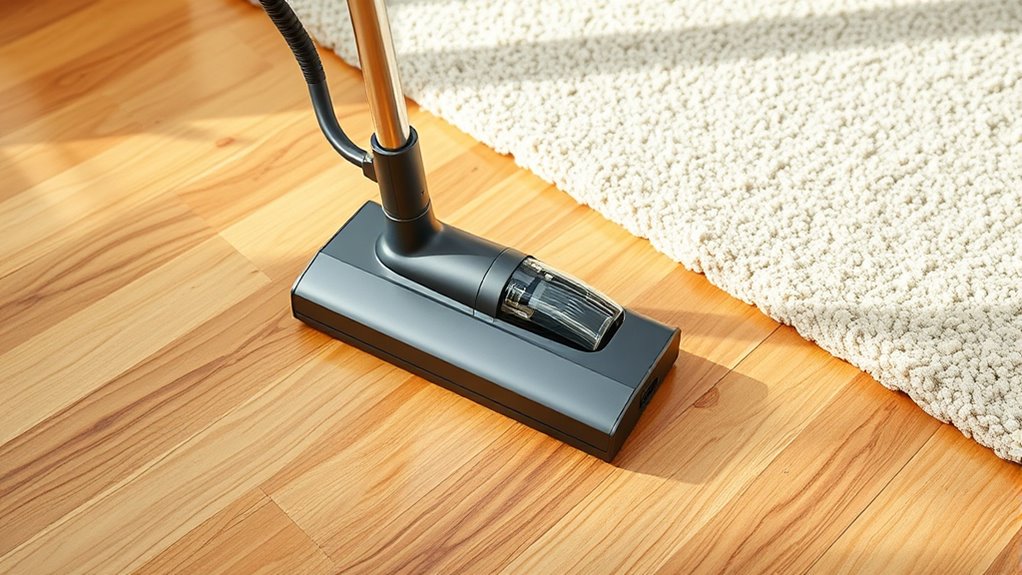
Choosing the right suction power setting is essential for effective vacuuming without causing damage or discomfort. Proper power adjustment guarantees you maintain suction consistency across different flooring types, preventing unnecessary wear or residue buildup. Start with a moderate setting and adjust as needed based on the surface. Higher suction may be necessary for carpets, while lower settings suit hardwood or delicate tiles.
Consider these tips:
- Test suction levels on small areas before full cleaning
- Use maximum power only when deep cleaning or removing stubborn debris
- Lower settings for sensitive surfaces to avoid scratches or damage
Balancing power adjustment helps you optimize suction consistency, making your vacuuming both efficient and safe for your floors.
Using Specialized Attachments for Delicate and Hard Surfaces

Using specialized attachments can markedly improve your cleaning results on delicate and hard surfaces. These tools allow you to target specific areas without risking damage, making your cleaning more effective. For hard floors and fragile surfaces, a soft brush or upholstery tool helps prevent scratches and preserves the finish. Cordless convenience means you can easily switch attachments without fumbling with cords, saving time and effort. Just verify your vacuum’s battery life can support switching between attachments without interruption. By choosing the right tools, you minimize the need for multiple passes, reducing wear on your floors and extending your vacuum’s lifespan. Proper attachment use ensures thorough cleaning while protecting delicate surfaces, making every pass more efficient and hassle-free. Additionally, selecting the appropriate vacuum settings for mixed flooring can further enhance cleaning efficiency and surface protection.
Navigating Transitions Between Carpet, Hardwood, and Tile
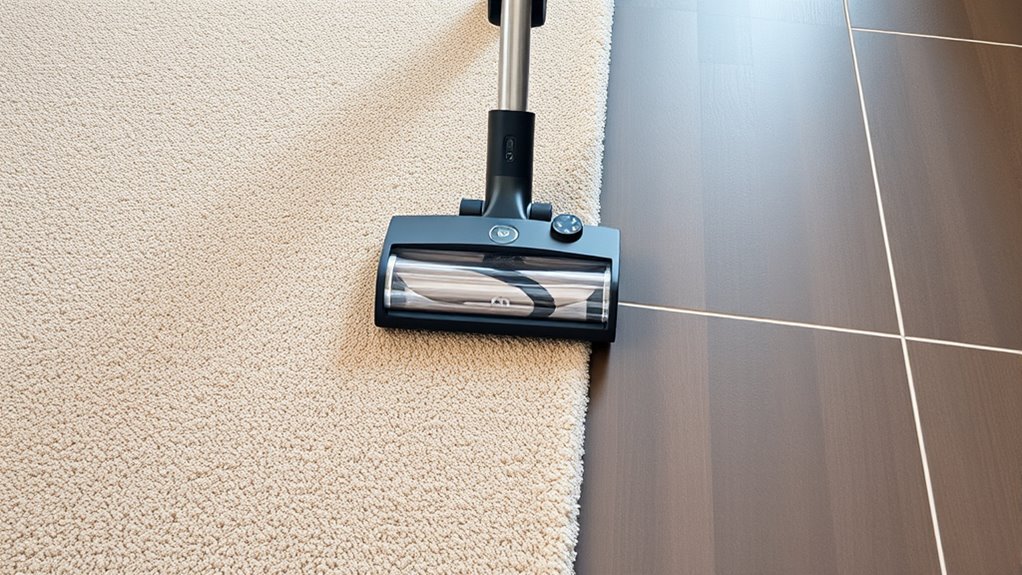
When moving between carpet, hardwood, and tile, you need to adapt your vacuum to match each surface. Properly selecting your suction power and attachments makes shifts smoother and more effective. Paying attention to thresholds helps prevent damage and guarantees thorough cleaning on every surface.
Adjusting Suction Power
Adjusting suction power is essential for effectively steering transitions between different flooring types. When you vary the suction, you improve dirt detection on carpets without damaging hardwood or tile surfaces, and you keep noise levels manageable. Lower suction works well on hardwood and tile, preventing scattering debris and reducing disturbance. Higher suction on carpets ensures deep dirt removal, especially where dirt detection is vital. To optimize cleaning, tweak the suction as you move between floors to maintain efficiency and quiet operation. Understanding industry trends can help you select the right settings for each surface.
- Use lower suction for hardwood and tile to minimize noise and prevent debris scatter
- Increase suction on carpets for thorough dirt detection and deep cleaning
- Adjust settings based on debris type and flooring sensitivity for best results
Selecting Appropriate Attachments
Choosing the right attachments is essential for effectively cleaning different flooring types as you move through your home. For carpets, use a motorized brush or beater bar attachment to loosen dirt, while a soft-bristled brush is better for hardwood and tile surfaces. Make certain your vacuum filter is suitable for capturing fine dust without clogging easily, especially when shifting between surfaces. When switching from carpets to hard floors, detach or switch to a hard-floor tool to avoid scattering debris. Keep an eye on your vacuum’s bag capacity; larger bags allow for longer cleaning sessions without frequent emptying, especially if you’re cleaning multiple floors. Proper attachments and filter choices optimize suction and prevent damage, making your cleaning more efficient across different flooring types. Additionally, using appropriate vacuum tuning can further improve performance and longevity of your vacuum cleaner.
Managing Transition Thresholds
As you move your vacuum from one flooring surface to another, paying attention to thresholds can make a significant difference in cleaning efficiency. Transition thresholds mark the surface transition points, like from carpet to hardwood or tile. Properly managing these thresholds ensures smooth operation and thorough cleaning. Adjust your vacuum height or brush roll speed when crossing different surface transitions to avoid damage or missed debris. Being mindful of the surface transition helps prevent the vacuum from getting stuck or causing scratches.
- Use a vacuum with adjustable height settings for seamless surface transitions
- Slow down when crossing transition thresholds to maintain control
- Consider a vacuum with specialized tools for different surface types to handle surface transitions smoothly
Managing Brush Roll Settings for Optimal Cleaning and Surface Protection
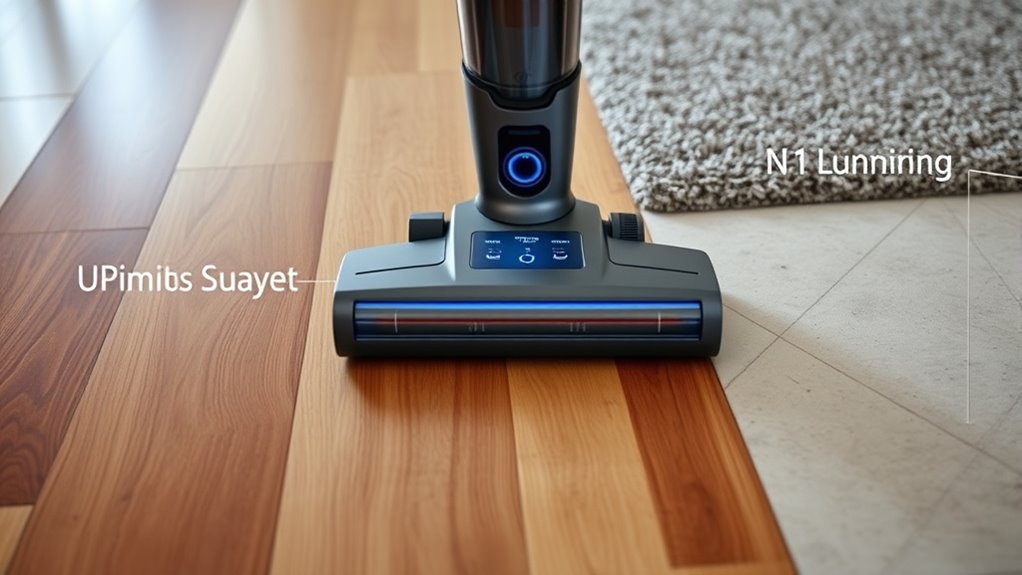
To achieve the best cleaning results while protecting your surfaces, managing your vacuum’s brush roll settings is essential. Adjusting the bristle strength helps prevent damage to delicate floors like hardwood while still effectively cleaning carpets. Use softer bristles on sensitive surfaces to avoid scratches and wear. For tougher surfaces, a higher bristle strength can lift dirt more efficiently. Keep noise levels in mind—setting the brush roll to a lower speed or softer bristles reduces noise, making your cleaning quieter and less disruptive. Regularly check and adjust these settings based on your flooring type. Proper management of bristle strength and noise levels guarantees thorough cleaning without compromising the integrity of your surfaces. This balance is key to efficient, surface-friendly vacuuming in mixed flooring areas. Additionally, choosing the appropriate Porsche Tuning Brands can ensure your vehicle maintains optimal performance and reliability after modifications.
Ensuring Proper Suction for Embedded Dirt and Debris
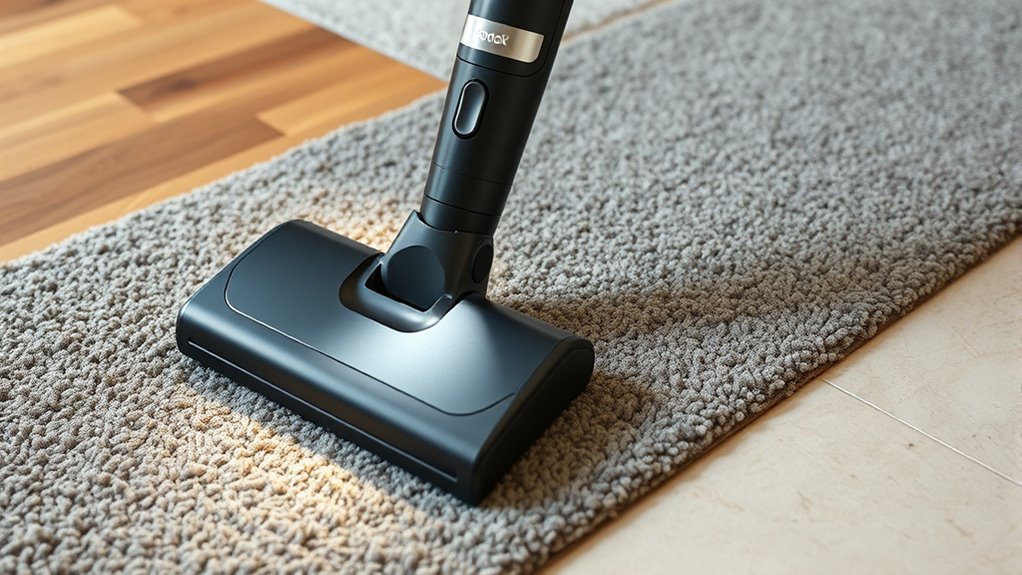
After adjusting your vacuum’s brush roll settings for different surfaces, it’s equally important to focus on maintaining proper suction. Strong suction ensures embedded dirt and debris are lifted effectively, improving air quality and preventing dust from recirculating. To enhance suction:
- Regularly check and clean the filters to maintain airflow and energy efficiency
- Clear blockages in hoses or nozzles promptly to prevent loss of suction
- Adjust suction strength based on debris type and flooring for thorough cleaning
- Practicing mindfulness during your cleaning routine can help you notice subtle changes in performance and address issues promptly to prevent small mistakes from leading to larger problems.
Proper suction not only enhances cleaning results but also minimizes energy waste, maximizing efficiency. Ensuring consistent suction helps your vacuum perform at its best across mixed flooring, safeguarding your indoor air quality and reducing energy consumption. Keep these practices in mind for optimal, one-pass cleaning.
Testing and Fine-Tuning Settings for a Seamless Cleaning Experience
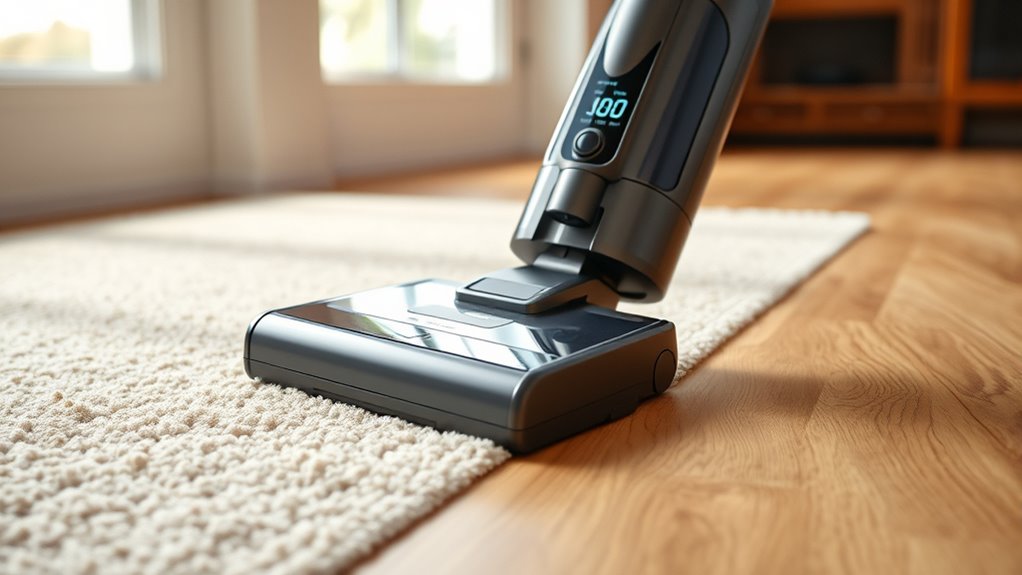
Testing and fine-tuning your vacuum’s settings guarantees you achieve ideal cleaning results tailored to your specific needs. Start by adjusting the vacuum filter to ensure proper airflow and filtration, which directly impacts suction power. Check that the filter isn’t clogged or dirty, as this can reduce cleaning efficiency. Next, manage your power cord carefully to prevent tangles and ensure smooth movement across different flooring types. Proper power cord management allows you to seamlessly switch between surfaces without interruptions. Experiment with different settings, such as adjusting suction strength or brush height, to find what works best for your mixed flooring. Regularly testing and refining these settings guarantees your vacuum performs at its peak, delivering a thorough, seamless clean every time.
Maintaining Your Vacuum for Consistent Performance
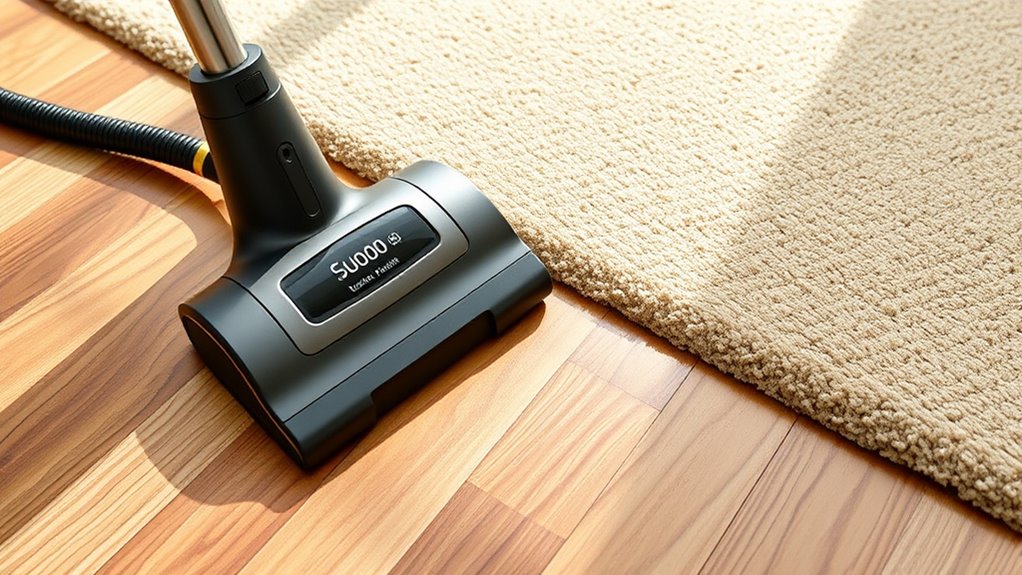
Regularly maintaining your vacuum guarantees it performs consistently and efficiently over time. To keep it in top shape, focus on vacuum filter maintenance—clean or replace filters as recommended to ensure ideal suction. Proper cord storage tips help prevent damage and prolong your vacuum’s lifespan, making sure the cord doesn’t tangle or wear prematurely. Additionally, check for tangled debris around brushes and replace worn brushes for better cleaning. Regularly empty the dustbin or replace the bag to avoid loss of suction. Keep the vacuum’s exterior clean to prevent dust buildup that can affect performance. By staying proactive with these simple maintenance steps, you’ll maintain consistent cleaning power and extend your vacuum’s lifespan, ensuring it works effectively on mixed flooring in one pass.
Frequently Asked Questions
How Often Should I Adjust Vacuum Settings for Changing Flooring Conditions?
You should regularly check and adjust your vacuum settings as flooring conditions change. Automatic sensors can detect dirt and adjust suction accordingly, so keep them clean and functional. For more precise control, you might need manual adjustments when switching between surfaces like hardwood or carpet. By staying attentive to your vacuum’s feedback and making necessary tweaks, you ensure ideal cleaning performance on all floor types.
Can I Automate Vacuum Adjustments for Different Surfaces?
Switching vacuum settings is like changing gears on a bike—manual adjustments can be a hassle. Luckily, automatic sensors and smart technology now enable you to automate these changes. Your vacuum can detect different surfaces and adjust suction power and brush height instantly. This hands-free approach simplifies cleaning, guarantees ideal performance, and keeps your floors protected, so you don’t have to worry about adjusting settings yourself.
What Are Signs My Vacuum Settings Aren’T Optimal?
If your vacuum noise seems unusually loud or inconsistent, it might indicate your settings aren’t right. Also, if you notice reduced suction power or it struggles to pick up debris, your current settings may not be ideal. Adjusting the vacuum properly ensures quieter operation and better cleaning performance. Pay attention to how your vacuum responds and sounds, which can help you identify when to tweak the settings for improved efficiency.
Are There Specific Vacuum Models Better for Mixed Flooring?
When choosing a vacuum model for mixed flooring, consider your specific needs and preferences. Some models excel at handling different surfaces with adjustable settings, making maintenance easier. Look for vacuums that allow quick height adjustments and have versatile attachments. Your user preferences, like lightweight design or powerful suction, should guide your choice. Investing in a reliable, adaptable vacuum guarantees efficient cleaning in one pass, saving you time and effort on varied flooring types.
How Do Environmental Factors Affect Vacuum Performance on Multiple Surfaces?
Imagine dust accumulation and humidity impact are tiny ninjas attacking your vacuum’s performance! These environmental factors can dramatically reduce suction power, making your vacuum work overtime. High humidity can cause dust to stick, clogging filters and brushes, while dust accumulation on surfaces makes it harder to pick up debris in one pass. To stay victorious, adjust settings and clean filters regularly, ensuring your vacuum conquers all surfaces effortlessly.
Conclusion
By mastering the right settings for each flooring type, you’ll keep your home spotless without breaking a sweat. Don’t be afraid to tweak and test until everything runs smoothly—after all, it’s better to be safe than sorry. With a little patience and attention, you’ll turn your vacuum into a cleaning powerhouse, making those shifts between surfaces as seamless as butter. Stick with these tips, and your floors will thank you!

